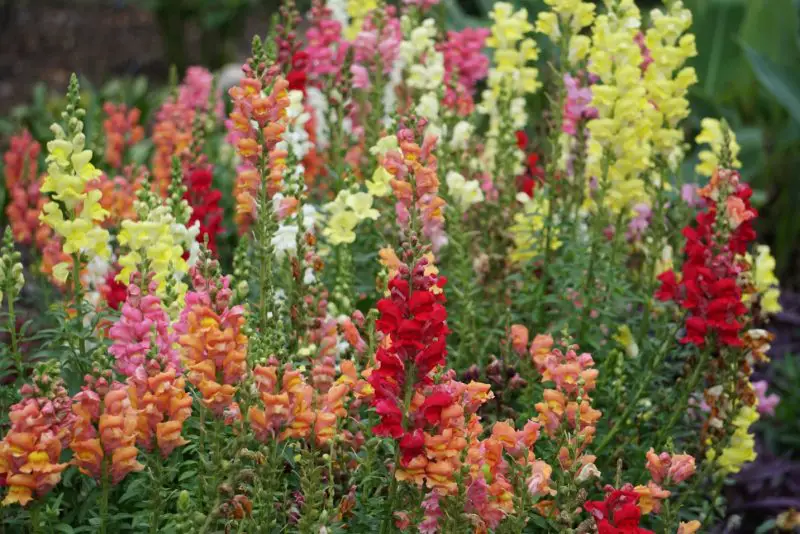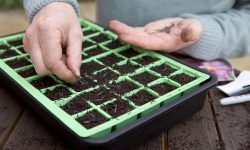Snapdragons bring a magical burst of color to any garden with their tall spires and playful, dragon-like blooms. From soft pastels to bold, fiery shades, they light up flower beds, borders, and containers with cheerful charm and vibrant energy.
But keeping these stunning flowers blooming throughout the season takes more than just planting and hoping. With the right care, timing, and attention, you can encourage wave after wave of blossoms that last until the final warm days of fall. Let’s explore how to keep snapdragons blooming with simple yet powerful tips that every gardener can follow.
Understanding the Snapdragon’s Blooming Cycle

Snapdragons (Antirrhinum majus) follow a distinct blooming cycle that is heavily influenced by temperature, light, and how well they’re cared for. These flowers thrive in cooler weather, which makes them perfect for early spring and fall gardens. In most regions, snapdragons begin blooming in early to mid-spring and continue through late spring or early summer, especially if the weather remains mild. Their ideal temperature range is between 60°F and 75°F (15°C to 24°C), and once temperatures consistently rise above that, blooming may slow or stop altogether.
During the heat of summer, many snapdragons go semi-dormant. They may stop flowering or produce fewer, smaller blooms. However, if the plants are kept healthy with consistent moisture, light feeding, and light trimming, they often bounce back in late summer or early fall when cooler temperatures return. This resurgence can result in a second wave of vivid blooms that last until the first frost.
Each flower spike blooms from the bottom up, meaning one stem can stay colorful for weeks if maintained properly. Recognizing this blooming pattern allows gardeners to deadhead spent flowers and trim strategically, stimulating more growth. With careful observation and seasonal care, snapdragons can reward you with multiple flushes of color throughout the growing season.
Choosing the Right Snapdragon Variety for Extended Blooming
To keep snapdragons blooming as long as possible, start by selecting the right variety. Snapdragons come in a range of types based on height, growth habit, and bloom cycle. Some are bred specifically for longer flowering periods and stronger heat tolerance, making them ideal for gardeners aiming for lasting color throughout the season.
Dwarf varieties, such as the ‘Floral Showers’ or ‘Montego’ series, bloom early and often, making them great for containers or front borders. These types typically require less maintenance and rebound quickly after pruning. Medium-height varieties like ‘Liberty’ or ‘Sonnet’ offer strong stems and continuous bloom when regularly deadheaded. If you’re looking for dramatic spikes and vertical color, tall types such as the ‘Rocket’ series are vigorous performers that bloom in waves with proper care.
Some newer hybrid series are bred for enhanced bloom longevity, including heat-tolerant types like ‘Snapshot’ or ‘Twinny’. These cultivars handle warmer weather better than traditional snapdragons, reducing the risk of mid-season bloom decline. Choosing a mix of early-, mid-, and late-season varieties can also stagger bloom times and ensure a succession of color in the garden from early spring to fall.
Always check the plant tag or seed packet for blooming time and climate adaptability. Pairing the right variety with the right care routine greatly increases your chances of keeping your snapdragons blooming for months on end.
Planting at the Right Time for Maximum Bloom
Timing is everything when it comes to keeping snapdragons blooming as long as possible. These cool-season flowers thrive in mild temperatures, and planting them at the right moment gives them the best chance to establish strong roots before heat or frost stress sets in.
In most regions, snapdragons should be planted in early spring, as soon as the soil is workable and the threat of hard frost has passed. However, in warmer climates—especially USDA zones 8 through 10—snapdragons can be planted in the fall for vibrant winter and early spring blooms. This fall planting gives them time to grow steadily in cooler weather and burst into color before the heat of summer arrives.
For gardeners in regions with long growing seasons, it’s possible to extend bloom time by succession planting. This means sowing new snapdragon seeds or transplanting young plants every few weeks from early spring through late summer. Doing so ensures that as one batch of flowers begins to fade, another is just reaching its peak.
When growing from seed, start your snapdragons indoors 8 to 10 weeks before your last expected frost date. Transplant them outdoors when nighttime temperatures consistently stay above 40°F (4°C). This early start helps the plants develop sturdy stems and encourages more robust blooming during the prime flowering window.
By aligning your planting schedule with your local climate and the snapdragon’s natural growth cycle, you’ll give your plants a head start and increase the odds of continuous, vibrant blooms well into the season.
Creating the Ideal Environment for Prolonged Flowering
o keep snapdragons blooming continuously, it’s essential to provide the right growing environment—one that encourages strong, healthy growth while minimizing stress. A well-cared-for snapdragon not only produces more blooms, but it also maintains vibrant color and vigor throughout the season.
Snapdragons thrive in locations that receive full sun for at least six hours a day. In cooler climates, full sun exposure maximizes flowering. In hotter areas, light afternoon shade can help protect the plants from intense heat, which can cause flowers to wilt or blooming to slow down.
Soil quality is another key factor. Snapdragons perform best in well-draining, nutrient-rich soil with a neutral to slightly acidic pH between 6.2 and 7.0. Before planting, amend heavy or compacted soil with compost or aged organic matter to improve aeration and moisture retention. Avoid overly rich soil that can lead to excessive foliage growth at the expense of blooms.
Consistent watering is also crucial. Snapdragons prefer moist but not soggy soil. Letting the soil dry slightly between waterings helps prevent root rot, while keeping the roots consistently hydrated ensures uninterrupted flowering. During dry spells or hot weather, deeper and more frequent watering may be necessary, especially for container-grown plants.
Air circulation plays a silent but important role in flower longevity. Crowded plants are more prone to mildew and other fungal diseases that can stunt growth and reduce blooming. Space your snapdragons properly based on their mature size and thin them as needed to allow for good airflow.
In regions with strong winds or heavy rains, consider staking taller snapdragon varieties to prevent breakage. Damaged stems can reduce bloom production, so structural support is helpful in keeping plants upright and healthy.
By fine-tuning light, soil, water, and spacing conditions, you create an environment where snapdragons feel at home—one that supports ongoing flower production and encourages each plant to reach its full blooming potential.
Watering Techniques to Encourage Continuous Blooms
Proper watering is one of the most effective ways to keep snapdragons blooming steadily throughout the season. These flowers prefer consistently moist soil, but they don’t tolerate soggy roots. The key is finding a balance—watering deeply but allowing the top inch of soil to dry out slightly before watering again.
Early morning is the best time to water snapdragons. This gives foliage time to dry during the day, reducing the risk of fungal diseases that can affect bloom quality. Use a watering can or drip irrigation at the base of the plant to avoid wetting the leaves and flowers, which helps preserve bloom color and health.
During hot or dry periods, especially in summer, increase watering frequency slightly to prevent stress that could halt blooming. For container-grown snapdragons, check moisture daily, as pots dry out faster than garden beds.
Applying mulch around the base of your snapdragons helps retain soil moisture and keeps roots cool, supporting a steady bloom cycle. With the right watering rhythm, your snapdragons will reward you with vibrant, ongoing displays of color.
Feeding Snapdragons for Lasting Color
Fertilization plays a key role in maintaining a steady supply of blooms. Snapdragons are moderate feeders, meaning they benefit from regular but not excessive feeding. A balanced fertilizer applied every 4 to 6 weeks during the growing season will promote healthy foliage and encourage repeated flowering.
Use a fertilizer with a balanced ratio such as 10-10-10 or one slightly higher in phosphorus, which supports flower development. Slow-release formulas can provide consistent nutrition, while liquid feeds offer a quick boost when blooming slows down.
Be cautious not to overfeed, as too much nitrogen can result in lush foliage at the expense of flowers. Always follow the recommended application rates, and adjust based on the plant’s response throughout the season.
Deadheading and Pruning to Extend the Bloom
Deadheading is one of the simplest and most effective techniques to keep snapdragons blooming for longer. As soon as flowers begin to fade, snip them off just above a healthy set of leaves or buds. This redirects the plant’s energy from seed production back into producing fresh blooms, leading to a fuller and more prolonged flowering display.
Regular deadheading not only encourages new flower spikes but also keeps the plant looking tidy and vibrant. For best results, check your snapdragons every few days and remove any wilted or browning blooms before they go to seed.
In addition to deadheading, light pruning can rejuvenate tired or leggy plants mid-season. If your snapdragons start to stretch or look sparse, trim the top few inches of growth just above a leaf node. This encourages branching and results in bushier growth with more flowering tips.
Late in the season, a slightly harder cutback may give your snapdragons a chance to rebound for a final burst of blooms before the weather turns cool. Whether in containers or garden beds, consistent pruning and deadheading can significantly extend the life and beauty of your snapdragon display.
Protecting Snapdragons From Summer Heat
Snapdragons thrive in cool weather and often struggle when summer temperatures rise above 80°F (27°C). Without protection, heat stress can cause blooming to slow or stop entirely, and plants may become leggy, wilted, or drop buds prematurely. To keep them blooming through the heat, you’ll need to create a more hospitable environment.
Start by providing afternoon shade, especially in hot climates. Plant snapdragons near taller companions, fences, or use shade cloth to filter harsh sunlight. This helps reduce leaf scorch and keeps roots cooler. In containers, move pots to shaded areas during peak heat hours to prevent overheating.
Mulching also plays a key role in keeping the soil consistently moist and cool. Apply a 2–3 inch layer of organic mulch like shredded bark or straw around the base of your snapdragons. This buffers temperature swings, slows evaporation, and keeps roots insulated from intense heat.
Watering becomes especially important during summer. Deep, consistent irrigation in the early morning allows moisture to reach the roots before the hottest part of the day. Avoid watering in the evening, as humid conditions overnight can lead to fungal issues.
If extreme heat persists, don’t be discouraged if flowering slows. Many snapdragons go semi-dormant during peak summer but rebound with fresh blooms once cooler weather returns in late summer or fall. By protecting them during the heat, you’ll ensure stronger regrowth and a longer blooming season overall.
Supporting Plants for Health and Longevity
Reviving Tired Snapdragons Mid-Season
As summer progresses, snapdragons may begin to look worn out—blooms fade, stems stretch, and overall vigor declines. But with the right care, you can rejuvenate these tired plants and encourage another flush of vibrant flowers.
Start by giving the plants a light mid-season haircut. Trim back about one-third of the plant’s height, focusing on leggy stems and faded flower spikes. This stimulates fresh growth and redirects energy into forming new buds rather than maintaining spent blooms.
Next, enrich the soil with compost or a light application of balanced fertilizer (like 10-10-10). Water thoroughly after feeding to help nutrients absorb effectively. Ensure the soil stays consistently moist but not soggy, especially during hot, dry periods.
If the plants are crowded or suffering from poor airflow, thin out nearby vegetation to reduce stress and the risk of disease. Also, remove any yellowing or damaged foliage to encourage healthy regrowth.
With this care, snapdragons often bounce back quickly, rewarding you with a renewed wave of blooms that carry your garden’s color well into late summer or even early fall.
Growing Snapdragons in Containers for Continuous Blooms
Selecting the Right Container
Choose a pot that’s at least 10–12 inches deep and wide enough to give the roots space to grow. Make sure it has multiple drainage holes to prevent waterlogging, which can quickly lead to root rot in snapdragons.
Using the Ideal Potting Mix
Use a high-quality, well-draining potting mix that includes organic matter like compost or peat moss. Avoid heavy garden soil, as it can compact in containers and limit root development. A light, aerated mix supports healthy roots and consistent flowering.
Positioning for Sunlight
Place your container in a location that receives at least six hours of direct sunlight per day. Snapdragons bloom best with full sun, although partial shade during the hottest part of the day can help reduce stress and prolong blooming in hotter climates.
Watering Container Snapdragons
Container-grown snapdragons need more frequent watering than in-ground plants. Check the top inch of soil daily and water thoroughly when it feels dry. During hot weather, this may mean watering every day or even twice a day to keep the soil consistently moist but not soggy.
Feeding for Long-Lasting Blooms
Apply a balanced, water-soluble fertilizer every two to three weeks throughout the growing season. Feeding regularly replenishes nutrients lost to frequent watering and helps the plant continue producing new buds and vibrant flowers.
Deadheading to Promote Fresh Blooms
Remove faded or spent blooms regularly to encourage the plant to keep flowering. Deadheading stops energy from going into seed production and redirects it to producing new buds, extending the bloom season significantly.
Managing Summer Heat in Containers
If summer temperatures rise above 85°F (29°C), move your container snapdragons to a location with some afternoon shade. Heat stress can cause flowers to fade or plants to stop blooming, so moderating their exposure keeps them healthy and productive.
Rotating and Refreshing Containers
If your container snapdragons begin to look tired mid-season, refresh the top layer of soil with compost and trim back leggy growth. You can also rotate containers every few weeks for more even sun exposure, preventing plants from leaning or becoming unevenly shaped.
By managing these container-specific care steps, you can keep snapdragons blooming beautifully from early spring through late fall.
Overwintering Snapdragons for Spring Blooms
Snapdragons are surprisingly resilient and, in many regions, can survive through winter with the right care. Overwintering your snapdragons not only saves you from replanting in spring but can also lead to stronger, earlier blooms when temperatures rise again.
Assessing Your Climate for Winter Survival
Snapdragons are typically hardy in USDA zones 7 through 10. In these areas, mature plants can often survive mild winters outdoors with minimal protection. In colder regions (zones 6 and below), overwintering indoors or using protective methods is essential to preserve your plants.
Preparing Outdoor Plants for Dormancy
In late fall, after the first light frost, cut back the plants to about 4–6 inches tall. This helps them conserve energy and reduces the chance of disease. Mulch heavily around the base using straw, shredded leaves, or compost to insulate the roots and keep the soil temperature stable during freezing conditions.
Moving Container Snapdragons Indoors
If your snapdragons are in pots, bring them indoors before hard frost sets in. Place them in a cool, bright spot, such as a sunroom or south-facing window. Reduce watering during winter dormancy, only watering when the soil feels dry several inches down.
Using Cold Frames or Row Covers
In borderline zones, protect in-ground snapdragons with row covers or cold frames. These structures trap heat during the day and reduce frost damage overnight. Ventilate them during sunny days to avoid overheating or excess humidity.
Reviving in Early Spring
As temperatures begin to warm in late winter or early spring, gradually reduce mulch and begin watering more frequently. Apply a balanced fertilizer to jumpstart growth. You’ll often see new green shoots appear from the base as early as late February or March in mild climates.
By overwintering your snapdragons properly, you’ll be rewarded with healthier plants and earlier blooms—often several weeks ahead of newly planted seedlings—helping you get a head start on a colorful garden season.
Common Problems That Affect Blooming
Lack of Sunlight
Snapdragons are sun-loving plants that require a minimum of six hours of direct sunlight each day to thrive. Without enough light, the plant struggles to produce energy through photosynthesis, leading to weak stems, sparse foliage, and few—if any—flowers. When grown in shaded conditions, even healthy snapdragons may refuse to bloom altogether. To fix this, always choose a planting site with full sun exposure or move container-grown plants to a brighter location during the day.
Overwatering or Poor Drainage
Snapdragons prefer consistently moist but well-draining soil. Overwatering or growing them in compacted, poorly draining soil can lead to root rot, a condition that restricts the plant’s ability to absorb nutrients and support flowering. Yellowing leaves, stunted growth, and drooping are signs of too much water. Ensure that the soil drains freely and water only when the top inch feels dry to the touch. Avoid letting containers sit in saucers full of water, especially after heavy rains.
Nutrient Imbalance
While snapdragons benefit from regular feeding, too much nitrogen can backfire. High-nitrogen fertilizers encourage lush, leafy growth but suppress the plant’s natural blooming cycle. If you notice lots of greenery but few flowers, it’s likely a nutrient imbalance. Use a balanced fertilizer with a higher phosphorus content (the middle number in N-P-K) to stimulate blooming. Feeding every 4–6 weeks during the growing season is typically sufficient for strong, consistent flower development.
High Temperatures
Snapdragons are cool-season annuals or short-lived perennials that perform best when daytime temperatures range between 60°F and 75°F (15°C to 24°C). Extended heatwaves, especially above 85°F (29°C), can stress the plant, causing flowers to fade quickly or halt new blooms entirely. In hot climates or during peak summer, provide afternoon shade or mulch the soil to keep roots cool. You can also consider planting heat-tolerant snapdragon varieties if summer temperatures regularly climb above their comfort range.
Failure to Deadhead
When spent flowers are left on the plant, snapdragons shift their energy toward producing seeds rather than creating more blooms. This natural response limits the plant’s flowering potential over time. Regular deadheading—pinching or cutting off faded flowers just above a set of healthy leaves—redirects energy back to growth and encourages the plant to produce a new flush of blooms. Make deadheading a part of your weekly routine to keep snapdragons vibrant throughout the season.
Pests and Diseases
Common garden pests like aphids, thrips, and spider mites feed on snapdragon sap, weakening the plant and reducing its ability to bloom. At the same time, fungal diseases such as powdery mildew, rust, or downy mildew can distort leaves and interfere with the plant’s growth. These stresses often lead to bud drop or poor flowering. Regularly inspect the plants for signs of infestation or infection and treat early with insecticidal soap or fungicides as needed. Good air circulation and proper spacing also reduce disease risk.
Overcrowding
Snapdragons that are planted too close together can become crowded, limiting airflow and sunlight access—two essential elements for healthy flowering. Overcrowding not only encourages disease but also causes plants to compete for soil nutrients and moisture, leading to weaker stems and fewer blooms. When planting snapdragons, provide ample spacing based on the variety’s mature size. Thinning or transplanting young seedlings early in the season can also improve overall plant vigor and bloom performance.
Companion Planting Strategies for Better Blooms
Companion planting is a natural and effective way to boost snapdragon blooms and support overall plant health. Choosing the right neighbors can enhance the environment around snapdragons, encouraging longer and more abundant flowering. Pollinator-attracting flowers like lavender, salvia, and cosmos help bring in bees and butterflies, which increase pollination and stimulate more continuous blooming. At the same time, aromatic herbs such as basil, thyme, and rosemary act as natural pest repellents, helping to deter harmful insects like aphids and spider mites without the need for chemical sprays. Legumes such as sweet peas or climbing beans can enrich the soil by fixing nitrogen, giving snapdragons a steady supply of nutrients to support healthy growth and prolific flowering. However, it’s best to avoid planting snapdragons near aggressive spreaders like mint or overly dense perennials, as these can overshadow or outcompete snapdragons for light, water, and nutrients—ultimately reducing flower production.
Harvesting Snapdragon Blooms for Cut Flower Displays
Snapdragons make exceptional cut flowers thanks to their tall spikes, vibrant hues, and long vase life. To enjoy their beauty indoors while encouraging more blooms in the garden, it’s important to harvest them properly and at the right time. The ideal moment to cut snapdragon stems is when just the bottom few florets on the spike have opened, and the rest are still in bud form. This ensures a longer-lasting display, as the upper flowers will continue to bloom gradually after cutting.
Use clean, sharp garden shears or scissors to make a diagonal cut in the early morning or late afternoon, when the plants are well-hydrated and temperatures are cooler. Immediately place the stems into a bucket of lukewarm water to prevent wilting. Removing any foliage that would sit below the waterline is essential, as this helps prevent bacterial growth and extends the freshness of the flowers.
Once indoors, arrange the snapdragon stems in a clean vase filled with fresh water and floral preservative, if available. Change the water every two days and recut the stems slightly each time to keep the flowers hydrated and vibrant. Regular harvesting not only enhances your indoor floral arrangements but also encourages the plant to redirect energy into producing new flower spikes, resulting in an extended blooming season in your garden.
FAQ About Keeping Snapdragons Blooming
How often should I deadhead snapdragons?
You should deadhead snapdragons every two to three days during their active blooming period. As soon as the lower florets on the flower spike begin to fade or turn brown, snip off the entire spent spike just above a healthy set of leaves or side shoots. This not only tidies up the plant but also signals it to produce new flower spikes rather than going to seed. Consistent deadheading can significantly prolong blooming well into late summer or early fall.
Can snapdragons bloom in summer?
Snapdragons can bloom in summer, but they thrive best in cooler temperatures ranging from 60°F to 75°F (15°C to 24°C). In regions with hot summers, flowering may slow or stop altogether. To help them survive and continue blooming during heat waves, plant them where they receive morning sun and afternoon shade. Mulch the soil to retain moisture and keep roots cool, and increase watering slightly during dry, hot spells. Choose heat-tolerant varieties like ‘Rocket’ or ‘Liberty’ for better summer performance.
Why did my snapdragons stop blooming?
Snapdragons may stop blooming for several reasons. High summer heat is the most common culprit, causing the plants to enter a dormant-like state. Other potential issues include overwatering, which can lead to root rot, or under-fertilizing, which results in nutrient deficiency. Additionally, if spent flowers aren’t removed regularly, the plant may begin seed production, halting bloom development. To restore blooming, prune back leggy stems by one-third, provide light fertilization, improve drainage if necessary, and give the plant time to recover as temperatures cool.
Will snapdragons rebloom after cutting back?
Yes, snapdragons are capable of reblooming after being cut back, especially if trimmed during midseason. Once the initial flush of flowers fades or the stems become leggy, cut them back by about one-third to one-half of their height. This rejuvenates the plant and promotes fresh growth, often leading to a second flush of blooms in late summer or early fall when temperatures are more favorable. Always water and lightly fertilize after pruning to support this new growth phase.
Should I fertilize snapdragons regularly?
Snapdragons benefit from consistent, moderate feeding. Apply a balanced, water-soluble fertilizer (such as 10-10-10 or 20-20-20) every 4 to 6 weeks throughout the growing season. Avoid fertilizers that are too high in nitrogen, as they promote leafy growth at the expense of flowers. For an organic option, use compost tea or fish emulsion in smaller, more frequent doses. Always water well after fertilizing to help nutrients reach the roots and to prevent fertilizer burn.
Conclusion: Keep the Color Coming All Season Long
Snapdragons aren’t just fleeting spring beauties—they’re resilient, expressive, and full of garden charm when cared for thoughtfully. With the right pruning, regular feeding, timely deadheading, and strategic placement, these spiky bursts of color can brighten up your beds, borders, and containers well into fall. Whether you’re growing them for their nostalgic appeal or their long-lasting cut flowers, a little attention goes a long way in keeping snapdragons blooming strong. Stay attentive, adapt with the seasons, and your snapdragons will reward you with layers of color that keep your garden—and your spirits—blooming all season long.






